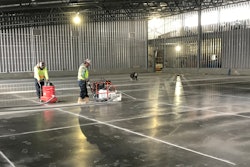
Increased quality, labor savings and tighter material yields are just a few of the benefits concrete contractors will see with laser-guided grading systems. Below are four success stories from contractors who run a variety of these systems.
Stepping into commercial
Chad Springborg, president of Chad Springborg Construction, Omaha, Neb., began his concrete business in 1994 specializing in residential concrete. About 10 years ago he started branching into commercial work. He knew in order to compete in the commercial market he would need to stay competitive with other commercial contractors and increase his jobsite production. In 1999, he purchased a Bobcat laser-guided grading attachment for his skid-steer loaders, enabling him to do fine grading on commercial building projects.
The system uses a Trimble total station mounted on a tripod and two transmitters mounted on the skid steer's grader attachment. Springborg's crews adjust the height of the transmitter to the desired grade and the laser system automatically moves the blade, fine grading the base to within ¼ inch plus or minus the designed grade as the operator moves across the jobsite.
Springborg says the laser grading system gives him better yields on his pours, decreasing his concrete overage from around 8 percent before he had the system to currently about 2 percent. Laser grading has also increased his productivity and decreased his labor. Paired with his Somero Laser Screed, Springborg says he can complete jobs three times faster than he could with his previous system.
Today Springborg's business is performing about 70 percent of its sales in the commercial sector. His typical jobsite is under 50,000 square feet, but Springborg says his laser-guided grading attachment is just as effective on larger jobs.
A few years ago, Springborg took his grading capabilities a step further when he purchased a Somero SiteShape System for a Caterpillar D4 dozer, a 3D grading system that allows him to fine grade multiple grade and elevation changes automatically. This, paired with his Somero 3D Profiler System for his Laser Screed, allows him to work effectively on concrete parking lots and sloped floors.
A versatile attachment
Shortly after purchasing a Somero Laser Screed in the late 1990s, Dean Madagan, president of Diamond Concrete Construction, Inc., in Spirit Lake, Iowa, realized his crews were having a difficult time getting the ground prepped by hand fast enough to keep up with the increased productivity they were seeing with the Laser Screed. "When you start pouring 30,000 to 40,000 square feet of concrete a day, grading the gravel by hand isn't feasible anymore - it takes too long and the accuracy isn't good enough," Madagan says.
So about 10 years ago Diamond Concrete Construction added a Dual Dozer laser grading attachment to its equipment arsenal. Not only did the laser grading equipment allow grading crews to stay ahead of the Laser Screed, it helped the company save a lot in labor costs. "We used to figure nine or 10 guys for a couple of days grading out a 30,000-square-foot slab," Madagan says. "The Dual Dozer knocked that down to two or three guys who can grade it out in a day."
The precision and speed Diamond Concrete Construction saw with its laser grading and concrete leveling systems came with another level of monetary benefits. "We went from running 3 to 5 percent overage on our concrete to being within 1 percent or less on our accuracy," Madagan explains. He adds that the Dual Dozer leaves a smooth-looking surface compared to the rough look you get with hand grading, cutting down on the number of GCs and owners second-guessing the grade.
The Dual Dozer by HitchDoc is a laser grading attachment that can be mounted to the front of a skid-steer loader or trailed behind a tractor with a three-point hitch. Diamond Concrete Construction has used it both ways, but has found it more effective following its New Holland TC45 SuperSteer tractor. "We use it behind the tractor because it's a little easier to see where pipes and other things are on the ground," Madagan explains. "We went with the tractor for visibility and because with the SuperSteer you can get tight to a corner and the wheels almost turn on a dime."
Madagan says he saw a full return on his investment the first year he ran his Dual Dozer, a year in which he laid about 1 million square feet of concrete. He says about 80 percent of the Dual Dozer's working time is on building slabs, with the other 20 percent on concrete parking lots. Madagan explains he can laser grade only about half of the parking lots he works on. His Dual Dozer has a dual receiver laser allowing him to grade sloped elevations, but on parking lots where the elevations are changing all the time his crews set forms and do the grading by hand. "If the elevations don't change too often we can still use the machine and just have to reset it every 50 feet if you can get the engineers to lay out the pad that way. We can grade it then change 1 or 2 percent to match the next elevation," he explains.
Laser grading with a full-size dozer
Two and half years ago, Tony Rutherford, president of R.4 Construction, LLC out of Ponce De Leon, Fla., had just lined up a lot of work. He was looking at a couple million square feet of grading, site work and concrete floor installation at an auto manufacturing facility and decided it was time to make an investment. He bought a Topcon System 5 elevation machine control unit for his Caterpillar D3 dozer to fine grade the stone base under his slabs-on-grade. With these jobs lined up he knew his return on investment would be fast and that the time savings would continue to benefit his company down the road.
Before the laser grading system, Rutherford did his fine grading work with the same dozer but with a lot more people working to accomplish the job. "Now with the laser dozer, the amount of stone or base we can put down has increased. We can cut the man power in half, if not more than that," he says. "I have so much ground to cover, and the laser allows me to do it more efficiently and much quicker than we used to do it."
Rutherford's system requires a laser mounted on a tripod or on a fixed object. The laser transmits a beam that is picked up by the laser receiver mounted on the dozer. The receiver then transmits the signal to the control box on the dozer which in turn controls the blade functions. Rutherford says the learning curve on the equipment was pretty much non-existent because he was able to pick up a few operators who were experienced in running the equipment.
"With a laser dozer, the blade is automatic. The equipment keeps the blade so precise that you fine grade the stone to within ¼-inch tolerance or better. A man running the machine is no comparison to the laser running the machine. What that gives you is the ability to be more productive as far as time is concerned and more profitable because you do the work so much quicker," he says.
Rutherford's jobs run anywhere from 25,000 to 800,000 square feet. Laser grading saves him time and money and has gotten him a few jobs he wouldn't have gotten without the system, something every contractor is looking for. "The economics of the labor you save is just one benefit. You also get better yields on your concrete since the closer you can get your stone to the design of the job, the better your yields will be. There are so many other things, too. The profit potential is raised because of the reduced labor, and it also helps me offer a cheaper cost, which might land jobs in the long run," he says.
Small package, big results
Concrete Crafters is a Connecticut company that specializes in machine-extruded concrete curbing and also offers full-depth slip-form cubing, trench curbing and pervious concrete. Concrete Crafters performs fine grading on its curbing jobs, an add-on service that allows the company to gain more dollars on a jobsite.
Three years ago, Concrete Crafters President Leon Burch purchased a Laser-Grader, an articulated, all-wheel-drive compact motor grader, to increase productivity and accuracy on these fine grading projects. Burch says the equipment was a huge step up from his previous system. "We were grading off the string line - it was quite expensive and labor intensive," he explains.
Now Burch is saving time and offering a superior product to his customers, achieving grade to at least a ¼ inch plus or minus. "Time savings is where this machine pays for itself," he says. "There aren't many other ways to achieve the precision this machine performs so it's hard to equate it to time savings, but in probably one-fourth the time it takes to grade otherwise - off string lines and reference points - this machine will do it and does it far more accurately."
Burch says the time savings start with cutting out the worker who previously followed around the grading equipment to ensure the operator was on grade. In addition, the Laser-Grader checks grade and the blade adjusts automatically, making it easier to train an operator.
Concrete Crafters isn't the only one benefiting from its laser grading system. "I did fine grading for a slab for a Big Y supermarket, and the concrete contractor that came in and placed the concrete with a Laser Screed said he never had the grade so good - his yield was dead on," Burch says. "The Laser Screed is real precise on the top of the floor, so the top is going to be right whether the bottom is or not. If the sub-base is undercut it's going to kill [your profits] on the yield; if it's overcut the entity may refuse the floor and that would be disastrous."
Burch adds because the Laser-Grader can be trailered by a heavy-duty pickup truck, they'll take it to their largest jobs and jobs that are only a couple hundred square feet.
He says the unit's compact size benefits in other ways. "The machine is articulated, all-wheel drive and compact so it gets into small, tight spaces, which is a plus for our type of work," Burch explains. "There are lots of big, cumbersome systems out there that aren't effective on small jobsites because you have to do so much handwork around corners, edging, plumbing and so on. The Laser-Grader has such good visibility and is so maneuverable it really minimizes the hand work."



















